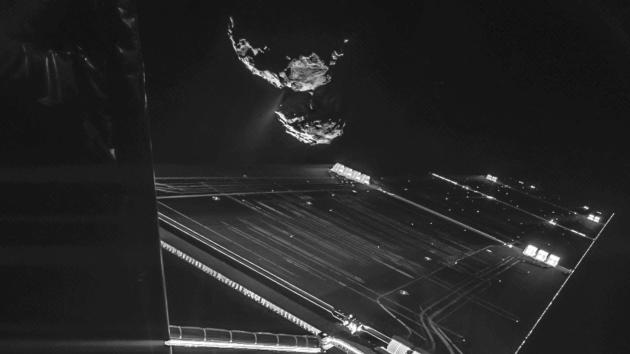
I'm sorry but this is quite explosive but it just gets a short Yahoo news item! Prof. Wickramasinghe is no new, clean shaven fella out to make a name for himself. Along with Sir Fred Hoyle he wrote the excellent Diseases From Space (1979), Evolution From Space (1981) and Life On Mars? (1997) along with many other books.
How ridiculous that organisations who send probes out into space to "learn" bicker over money and decide not to equip probes with something that might just show us that there is 100% "life out there!"
*******************************************************************************
Evidence of alien life is "unequivocal" on the comet carrying the Philae probe through space, two leading astronomers have said.
Rosetta, the European spacecraft orbiting the comet, is also said to have picked up strange "clusters" of organic material that resemble viral particles.
But neither Rosetta nor its lander probe, Philae, are equipped to search for direct evidence of life after a proposal to include this in the mission was allegedly dismissed.
Astronomer and astrobiologist Professor Chandra Wickramasinghe, who was involved in planning for the mission 15 years ago, said: "I wanted to include a very inexpensive life-detection experiment. At the time it was thought this was a bizarre proposition."
He and colleague Dr Max Wallis, from the University of Cardiff, believe 67P and other comets like it could provide homes for living microbes similar to the "extremophiles" that inhabit the most inhospitable regions of the Earth.
They say comets may have helped to sow the seeds of life on Earth and possibly other planets such as Mars early in the solar system's existence.
Philae failed to attach itself to the surface of Comet 67P after being dropped by mothership Rosetta in November, and bounced several times before landing in the shade.
After being forced into hibernation by the lack of sunlight reaching its solar panels, scientists were euphoric when it began "waking up" as the comet raced towards the sun. It is currently about 176.7 million miles from Earth and travelling at more than 73,000 mph.
Computer simulations have suggested microbes could inhabit the comet's watery regions.
It has a black hydrocarbon crust overlaying ice, smooth icy "seas", and flat-bottomed craters containing "lakes" of re-frozen water overlain with organic debris.
Prof Wickramasinghe said: "What we're saying is that data coming from the comet seems to unequivocally, in my opinion, point to micro-organisms being involved in the formation of the icy structures, the preponderance of aromatic hydrocarbons, and the very dark surface.
"These are not easily explained in terms of pre-biotic chemistry.
"The dark material is being constantly replenished as it is boiled off by heat from the Sun. Something must be doing that at a fairly prolific rate."
Another tantalising find was the discovery of organic "particle clusters" by Rosetta in the gases surrounding the comet, which resembled viral particles collected from the Earth's upper atmosphere.
"They might be viral particles," said Prof Wickramasinghe."The current estimate for the number of extra-solar planets in the galaxy is 140 billion plus. Planets that can harbour life are really quite abundant in the galaxy, and the next neighbouring system to us is only spitting distance away. I think it's inevitable that life is going to be a cosmic phenomenon.
"Five hundred years ago it was a struggle to have people accept that the Earth was not the centre of the universe. After that revolution our thinking has remained Earth-centred in relation to life and biology.
"It's deeply ingrained in our scientific culture and it will take a lot of evidence to kick it over."

 The
book also calls Apostle Paul “The Impostor”. The book also claims that
Jesus ascended to heaven alive, and that Judas Iscariot was crucified in
his place.
The
book also calls Apostle Paul “The Impostor”. The book also claims that
Jesus ascended to heaven alive, and that Judas Iscariot was crucified in
his place.